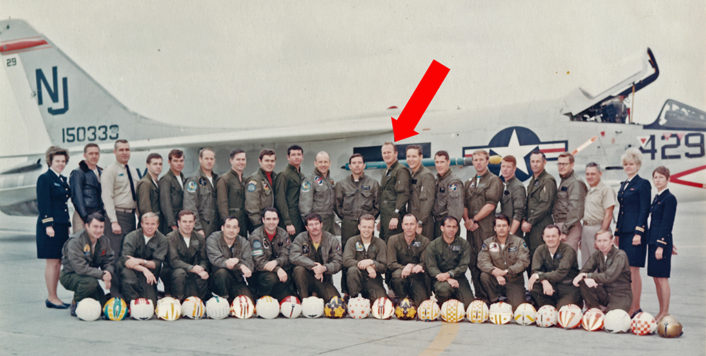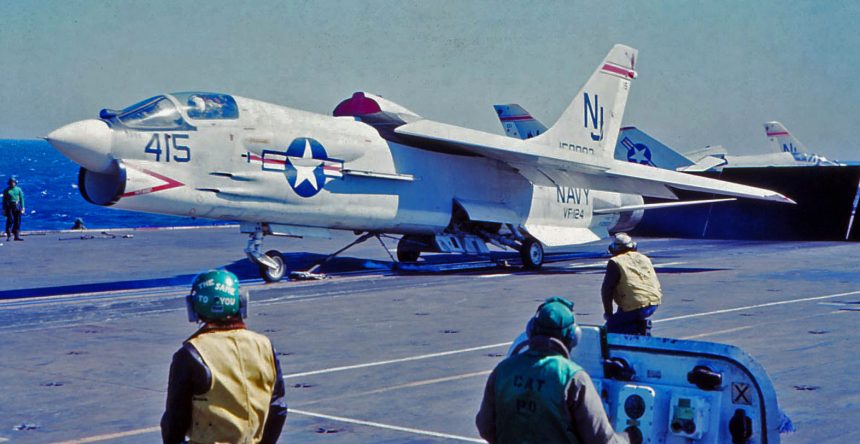Satrapa Advocated Use of Guns in Modern Dogfighting; His Influence Remains Today.
Legendary U.S. Navy F-8E Crusader pilot and aerial gunnery advocate Commander Joe “Hoser” Satrapa passed away on Mar. 17, 2019. He was 78 years old.
CDR. Joe “Hoser” Satrapa flew 162 combat missions during the Vietnam conflict and made “more than 500 arrested landings” on board aircraft carriers during his career according to sources across social media and the internet who eulogized him.
CDR. Satrapa has been a largely unheralded naval aviator in mainstream media, but his contributions to tactics and, to an even greater degree, the lore of Navy fighter pilots, is significant. He remains legendary among the tight inner circle of naval aviators.
“Hoser” Satrapa’s career and persona helped establish and perpetuate the image of the naval aviator as a swashbuckling, authority-challenging maverick. His life was instrumental in the creation of fictional Naval aviators in popular film depictions like the Hollywood blockbuster, “Top Gun”.
During an era when the U.S. Navy had adapted an air combat doctrine that relied increasingly on air-to-air missiles and the new F-4 Phantom II, Satrapa continued to advocate for guns being mounted on fighter aircraft.
While Satrapa flew many aircraft during his Navy career, including the large RA-5C Vigilante twin-engine supersonic carrier-borne reconnaissance jet and the EC-121 four-radial engine propeller early warning, electronic warfare and surveillance aircraft, “Hoser” was best known for his combat flying in the supersonic, single-engine, single-seat Vought F-8E Crusader.

The Crusader, a classic high-performance dogfighting and air superiority fighter, was armed with four Colt Mk12 20mm cannons, two on each side of the fuselage below and behind the cockpit. The aircraft also carried fuselage mounts for four AIM-9 Sidewinder air-to-air missiles as well as underwing mounts for additional stores including air-to-ground munitions.
While flying and fighting in his F-8E Crusader over North Vietnam, CDR. Satrapa was famous for the personal arsenal that he wore on his flying kit in the event he was shot down. According to anecdotes shared in social media by fellow squadron members, Satrapa reportedly carried “Two Mark 33 hand grenades, a Colt Python .357 revolver with 60 rounds of ammunition, a Smith & Wesson 9mm with non-NATO hollow-point ammunition and 3 spare magazines, a custom Randall survival knife and an additional throwing knife over his left shoulder.”

So many remarkable anecdotes about CDR. Joe “Hoser” Satrapa exist, they are difficult to summarize in one tribute.
Satrapa graduated from the U.S. Naval Academy at Annapolis in 1964. Following his commission and assignment to pilot training, CDR. Satrapa earned his callsign “Hoser” after repeatedly missing practice targets in aerial gunnery practice at El Centro, California. Satrapa was reportedly frustrated by his initial poor performance on the aerial gunnery range after failing to score a single hit in three passes at a target. On his fourth attempt to destroy the target as a member of a four-aircraft element, Satrapa, “Cut off number three during the last gunnery circuit, then “hosed” all his remaining ammunition at the target . . . missing it again! After being chewed out by his mission leader for his lack of in-flight discipline, Satrapa was awarded the call sign “Hoser.” The anecdote about his call sign origin has been repeated in tributes around the internet this week following Satrapa’s passing.
One tribute to Commander Joe “Hoser” Satrapa including the epitaph, “Hoser was well known for his don’t-give-a-crap-about-paperwork attitude and the lack of deference he showed non-aviators, especially those of higher rank. Because of his ‘administrative deficiencies’, he was forced out of the Navy as an 0-4 in the early 1980’s.” But this forced administrative hiatus was not the end of “Hoser” Satrapa’s remarkable life and career in the air.
In 1981, former U.S. Navy A-6 Intruder crew member and contemporary of Joe Satrapa, Commander John Lehman, became the Secretary of the Navy under then-President Ronald Reagan. Almost immediately upon his appointment, Navy Secretary Lehman brokered a presidential order from Ronald Reagan to restore Joe Satrapa’s commission as a Naval Aviator, but with a retroactive promotion to O-5 (Commander). On the day Joe “Hoser” Satrapa returned to the Navy with his retroactive promotion, Naval Secretary Lehman personally awarded “Hoser” Satrapa his Commander’s rank.
Hoser was immediately assigned to the fledgling Navy Fighter Weapons School at Miramar, California. The school is popularly known as “Top Gun”. Now-Commander Joe Satrapa was placed in command of the Grumman F-14 Tomcat training gun training syllabus, the very same doctrine “Hoser” Satrapa had espoused while flying the F-8E Crusader during the Vietnam War. Contrary to his callsign, “Hoser” established a reputation as a lethal and accurate air-to-air gunnery marksman in the F-14 Tomcat.
As a part of his training syllabus, some sources recounted that Joe “Hoser” Satrapa delivered his initial lecture as an adaptation of General George Patton’s famous flag speech.
In another classic “Hoser” anecdote, CDR Joe Satrapa was experimenting with a 20mm cannon from an F-14 Tomcat when, “One day while Hoser was playing around with his new invention, the breach blew up taking off Hoser’s right index finger and thumb. Note that a right thumb is essential for flying a jet fighter because the electric trim tab is located on the top of the control stick where the pilot’s thumb rests while holding the stick. Thus, a pilot without a right thumb cannot fly a jet fighter.”
But according to the now famous anecdote posted on the Naval Academy alumni blog, the loss of his right thumb would not stop “Hoser” from flying fighter aircraft. “He convinced the surgeon to take off his right big toe and attach it to his right hand . . . now he had three fingers and a big toe. It looked a bit like a lobster claw but Hoser demonstrated that he could operate the trim button, so he went back on flight status . . . with a new call sign, “Toeser”. Hey, you just can’t make this stuff up.”
Dealing with the decision to have his Big Toe transplanted to his right hand here’s what Dale “Snort” Snodgrass, another legendary F-14 pilot (do you remember that crazy shot of a Tomcat buzzing USS America?) has written about Hoser:
During his time at Top Gun, CDR Joe “Hoser” Satrapa continued to add to his legacy of outlandish and remarkable true stories. During one training sortie intended to be a 2-on-2 engagement between two navy F-14s and two U.S. Air Force F-15 Eagles, one of the F-14s remained on the ground with a maintenance issue. Undaunted, “Hoser” Satrapa continued with the training sortie and engaged the two USAF F-15s alone, masquerading as a pair of F-14s instead of just one by pretending his back-seater was actually in another (non-existent) F-14 when he was actually seated behind Satrapa in the same F-14. The rest of the remarkable story is best recounted directly from one of Satrapa’s fellow pilots:
“The Eagles get tally of one [F-14] at the merge. They break their necks looking for the other Tomcat, which is still back on the ground at VF-101. ‘Hoser’, the master of the slow fight, maneuvers in for one gun kill, then another- both F-15s killed.”
“The F-15 pilots call, ‘Knock it off! Knock it off!’. The Eagle drivers are pissed when they realize the ‘two-ship’ of F-14s was only “Hoser” and his backseater in one Tomcat. Now it’s a known, 1 vs. 2 engagement and the F-15 Eagle drivers, one Major and Lt. Col, were hot to ‘kill’ Hoser’s lone F-14. Fight’s on! Picture afterburner spouting from the F-15s and ‘Hoser’ in his F-14 working his flaps in a ‘non-landing configuration’, cartwheeling and pivoting across the sky like Mary Lou Retton on steroids. He gets gun kill number 3, then number 4 against to the two F-15s”.
Another “Hoser” story alleged that Joe Satrapa nearly compromised a U.S. sales contract for F-15 Eagle fighters to Japan when he demonstrated his dogfighting superiority in the F-14 Tomcat against the F-15 Eagle. The incident was said to cause the Japanese to consider cancelling their F-15 orders in favor of the F-14 Tomcat.
Here’s what we wrote about this episode in a previous article on “Hoser” (also known as “Da-Hose” or “D-hose”):
[…] Hoser’s best experience during the AIMVAL/ACEVAL most probably came after the end of the trials. Even if Tomcat and Eagle drivers could not engage each other, Hoser and his RIO Bill “Hill Billy” Hill with Dan “Turk” Pentecost and Frank “Fearless” Schumacher onboard the second F-14, went 2 vs 2 against a couple of F-15 instructors from 415th Training Squadron (415th Flight Test Flight).
Both Eagles were gunned down and a gun camera film which showed the F-15 locked in the F-14 HUD almost caused Japan to revert its decision to buy the Eagle.
The anecdotes about Commander Joe “Hoser” Satrapa are nearly infinite, and in the week following his passing more and more stories surfaced on small, often private fighter pilot association forums.
Following his remarkable Navy flying career that still exerts influence on air combat doctrine, Joe Satrapa began flying a twin-engine propeller driven S-2 Tracker firefighting aircraft. Satrapa’s mission was to work in conjunction with a light pathfinder aircraft, often an OV-10 Bronco, and deliver liquid fire retardant drops on California wildfires.
Satrapa’s harrowing flying stories continued as an aerial firefighter when the windscreen of his S-2 Tracker was completely obscured by another aircraft above him dropping fire retardant on his own aircraft. Satrapa opened a window on his S-2 Tracker in flight, reached outside and wiped a small patch of his windscreen clear of the opaque fire retardant so he could see well enough to avoid hitting the ground and eventually land the aircraft safely.
While the saying among aviators is, “There are old pilots, and there are bold pilots, but there are no old, bold pilots”, Commander Joe “Hoser” Satrapa clearly defied that belief. To his final days before passing away peacefully in a California hospital last week surrounded by family, Command Joe “Hoser” Satrapa pushed the boundaries of aviation and established new limits well beyond those previously recognized. His illustrious career in military and civilian aviation compares to aviators like Chuck Yeager, John Glenn and the greats of flying history.
Thanks to former F-14 RIO and Air Force Academy graduate Mr. Dave Parsons for his kind assistance with research for this article.









